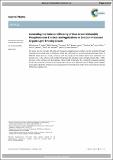Controlling the emission efficiency of blue-green iridium(III) phosphorescent emitters and applications in solution-processed organic light-emitting diodes
Date
14/10/2016Author
Grant ID
EP/J01771X/1
ep/l017008/1
EP/M02105X/1
EP/K031252/1
Metadata
Show full item recordAbstract
We show that the emission efficiency of blue-green phosphorescent emitters can be controlled through coupling of the excited state to vibrational modes. We controlled this vibrational coupling through choice of different ligands and as a result, complexes with CF3-groups on the ancillary ligand were essentially non-emissive (ΦPL < 1%), whereas with isosteric CH3-groups the complexes were strongly emissive (ΦPL > 50%). Emission of the complexes can be drastically improved (30 times higher ΦPL compared to degassed solution for the CF3-containing complexes) by blending them with an inert solid host such as PMMA, which mitigates metal-ligand vibrations. Solution-processed organic light-emitting diodes made from these materials showed efficiency as high as 6.3%.
Citation
Sajjad , M T , Sharma , N , Pal , A K , Hasan , K , Xie , G , Kölln , L S , Hanan , G S , Samuel , I D W & Zysman-Colman , E 2016 , ' Controlling the emission efficiency of blue-green iridium(III) phosphorescent emitters and applications in solution-processed organic light-emitting diodes ' , Journal of Materials Chemistry , vol. 4 , no. 38 , pp. 8939-8946 . https://doi.org/10.1039/C6TC02909D
Publication
Journal of Materials Chemistry
Status
Peer reviewed
ISSN
0959-9428Type
Journal article
Description
We are grateful to the European Research Council (grant 321305), EPSRC (grants EP/J01771X/1, EP/L017008/1 and EP/M02105X/1) for financial support. IDWS acknowledges a Royal Society Wolfson Research Merit Award. GSH thanks the Natural Sciences and Engineering Research Council (NSERC) of Canada for funding.Collections
Items in the St Andrews Research Repository are protected by copyright, with all rights reserved, unless otherwise indicated.

